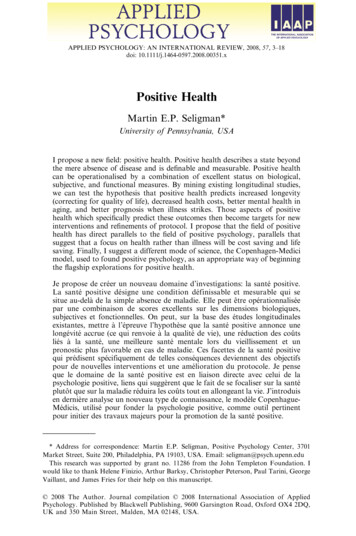
Transcription
APPLIED PSYCHOLOGY: AN INTERNATIONAL REVIEW, 2008, 57, 3–18doi: lOxford,AppliedAPPS ive HealthMartin E.P. Seligman*University of Pennsylvania, USAI propose a new field: positive health. Positive health describes a state beyondthe mere absence of disease and is definable and measurable. Positive healthcan be operationalised by a combination of excellent status on biological,subjective, and functional measures. By mining existing longitudinal studies,we can test the hypothesis that positive health predicts increased longevity(correcting for quality of life), decreased health costs, better mental health inaging, and better prognosis when illness strikes. Those aspects of positivehealth which specifically predict these outcomes then become targets for newinterventions and refinements of protocol. I propose that the field of positivehealth has direct parallels to the field of positive psychology, parallels thatsuggest that a focus on health rather than illness will be cost saving and lifesaving. Finally, I suggest a different mode of science, the Copenhagen-Medicimodel, used to found positive psychology, as an appropriate way of beginningthe flagship explorations for positive health.Je propose de créer un nouveau domaine d’investigations: la santé positive.La santé positive désigne une condition définissable et mesurable qui sesitue au-delà de la simple absence de maladie. Elle peut être opérationnaliséepar une combinaison de scores excellents sur les dimensions biologiques,subjectives et fonctionnelles. On peut, sur la base des études longitudinalesexistantes, mettre à l’épreuve l’hypothèse que la santé positive annonce unelongévité accrue (ce qui renvoie à la qualité de vie), une réduction des coûtsliés à la santé, une meilleure santé mentale lors du vieillissement et unpronostic plus favorable en cas de maladie. Ces facettes de la santé positivequi prédisent spécifiquement de telles conséquences deviennent des objectifspour de nouvelles interventions et une amélioration du protocole. Je penseque le domaine de la santé positive est en liaison directe avec celui de lapsychologie positive, liens qui suggèrent que le fait de se focaliser sur la santéplutôt que sur la maladie réduira les coûts tout en allongeant la vie. J’introduisen dernière analyse un nouveau type de connaissance, le modèle CopenhagueMédicis, utilisé pour fonder la psychologie positive, comme outil pertinentpour initier des travaux majeurs pour la promotion de la santé positive.* Address for correspondence: Martin E.P. Seligman, Positive Psychology Center, 3701Market Street, Suite 200, Philadelphia, PA 19103, USA. Email: seligman@psych.upenn.eduThis research was supported by grant no. 11286 from the John Templeton Foundation. Iwould like to thank Helene Finizio, Arthur Barksy, Christopher Peterson, Paul Tarini, GeorgeVaillant, and James Fries for their help on this manuscript. 2008 The Author. Journal compilation 2008 International Association of AppliedPsychology. Published by Blackwell Publishing, 9600 Garsington Road, Oxford OX4 2DQ,UK and 350 Main Street, Malden, MA 02148, USA.
4SELIGMANINTRODUCTIONHealth is a state of complete positive physical, mental, and social well-beingand not merely the absence of disease or infirmity. (Preamble to the Constitution of the World Health Organization, 1946)The mere absence of disease is often taken to be equivalent to health.Disclaimers such as WHO’s above, those in the charter of the NationalInstitute of Health, and on the wall at the entrance of Robert WoodJohnson health-care oriented Foundation’s headquarters in Princetonnotwithstanding, a scientific discipline of health—beyond the mere absenceof disease—barely exists. This paper is the call to such a discipline.In this paper, I first discuss the rationale for positive health, grounded asit is in the field of positive psychology. I then outline the parallel conceptualframework within which positive health can be defined and operationalised.Thereupon I discuss the predictions—increased longevity, decreased healthcosts, better mental health, and better prognosis—that follow from thisframework and the flagship activities for testing these predictions empirically. I then suggest a different scientific structure, the Copenhagen-Medicimodel for carrying out these studies expediently. I conclude with the potentialnovel and inexpensive interventions that successful prediction would entail.RATIONALEI was elected President-elect of the American Psychological Association in1996. As I surveyed a century of accomplishments (and their lacunae), Iargued that psychology and psychiatry had done reasonably well with mentalillness: suffering, victims, depression, anger, substance abuse, and anxiety.But they had done very poorly with mental health: positive emotion, engagement, purpose, positive relationships, and positive accomplishment.And it was clear that mental health was not the mere absence of mentalillness. Clinically, the positive states of mental health did not reliably ensuewhen the disorders ended, and statistically, the correlation between “happiness” and depression is not close to what Freud and Schopenhauer (the besthuman beings can ever hope for is the absence of misery) would expect—minus 1.0. Rather it is closer to minus 0.35. The mental disorders, in short,somewhat impede, but do not remotely preclude, positive emotion, engagement, purpose, positive relationships, and positive accomplishment (Haidt,2006; Lyubomirsky, 2007; Seligman, 2002).Why, however, in a world of suffering should one bother to work onmental health, well-being, and happiness in the first place? Perhaps, in a fewhundred years when AIDS and Alzheimer’s disease and suicide are all conquered, we should then turn science to the enabling of well-being. Surely 2008 The Author. Journal compilation 2008 International Association of AppliedPsychology.
POSITIVE HEALTH5suffering trumps happiness, both in the priority for brains and for funding.There are two good reasons why this is wrong. The first is obvious: Peopledesire well-being in its own right, and they desire it above and beyond therelief of their suffering. The second is less obvious: Bringing about well-being—positive emotion, engagement, purpose, positive relationships, positiveaccomplishment—may be one of our best weapons against mental disorder.This is testable, and a substantial body of research, the best of it usingprospective, random assignment, and placebo controlled designs, now suggeststhat interventions that build the positive states alleviate depression (Seligman,Rashid, & Parks, 2006; Seligman, Steen, Park, & Peterson, 2005). The nontautological inference from such studies is that building mental healthprevents and relieves mental illness.The findings that have emerged from the positive psychology initiativehave not been confined to positive interventions (see Peterson, 2006, for areview). Many of the findings are not of the “my grandmother already knewit” variety; among the more surprising ones: Women who flashed a Duchenne (genuine) smile in their yearbookpositive photos as freshmen have more marital satisfaction twenty-fiveyears later (Harker & Keltner, 2001). Brief raising of positive mood enhances creative thinking and makespositive physicians more accurate and faster to come up with theproper liver diagnosis (Fredrickson, 2001; Isen, 2005). The relation of national wealth to life satisfaction is dramatically curvilinear; after the safety net is met, increases in wealth produce less andless life satisfaction (Diener, Sandvik, Seidlitz, & Diener, 1993). In business meetings a ratio of greater than 2.9:1 for positive to negativestatements predicts economic flourishing (Fredrickson & Losada, 2005). Peripheral attention is superior under positive emotion (Fredrickson &Branigan, 2005).Some newer findings concern optimism predicting cardiovascular disease(CVD) and mortality and these studies bear directly on the likelihood thata state of positive health will increase longevity and improve prognosis: Giltay, Geleijnse, Zitman, Hoekstra, and Schouten (2004) followed999 Dutch seniors for a decade: high optimism produced a remarkablylow hazard ratio of 0.23 for CVD death (upper versus lower quartileof optimism, 95% confidence interval, 0.10–0.55) when controlling forage, sex, chronic disease, education, smoking, alcohol, history of CVD,body mass, and cholesterol level. Similarly, Buchanan (1995) foundthat among 96 men who had had their first heart attack, 15 of the 16most pessimistic men died of CVD over the next decade, while only 5of the 16 most optimistic died, controlling for major risk factors. 2008 The Author. Journal compilation 2008 International Association of AppliedPsychology.
6SELIGMAN Kubzansky, Sparrow, Vokonas, and Kawachi (2001) followed 1,306men who were evaluated by the MMPI Optimism–Pessimism scale.In a 10-year follow-up, incidence of coronary heart disease (CHD),non-fatal myocardial infarction, fatal CHD and angina pectoris wererecorded. A robust positive correlation was found between increasinglyhigh levels of optimism and increased protection against each of thecardiovascular events and depression significantly increase the risk forcardiac events. Similarly Kubzansky and Thurston (2007) found a strongpositive relationship between emotional vitality and lack of CVD. Optimism and positive emotions have also been linked to recoveryafter a major cardiac event. Leedham, Meyerowitz, Muirhead, andFrist (1995) interviewed 31 heart-transplant patients both before andafter surgery. Those who reported a high level of positive expectationand good mood before the surgery were found to have greater adherenceto medical regimen after surgery, as well as a better status report obtainedby nursing 6 months post-operation. Scheier, Matthews, Owens, Magovern, Lefebvre, Abbott, and Carver(1989) investigated the effect of dispositional optimism in 51 middle-agedmen who had coronary artery bypass surgery. Dispositional optimismwas associated with faster recovery rates during hospitalisation, as wellas a speedier return to normal living upon discharge. At the 6-monthfollow-up, there was a strong positive association between high optimismand good quality of life. Optimism and positive affect may also be protective against other physicaldeteriorations. Ostir, Ottenbacher, and Markides (2004) followed 1,558initially non-frail older Mexican-Americans for 7 years. Frailty increasedby 7.9% over the course of follow-up, but those men with high positiveaffect were found to have a significantly lower risk of frailty onset. Positive emotional style (PES) may also act as preventive against theonset of the common cold. Cohen, Alper, Doyle, Treanor, and Turner(2006) administered nasal drops carrying either rhinovirus or influenzato 193 healthy normal volunteers, ranging in age from 21 to 55. They foundthat a high level of PES was associated with a lower risk of developingeither of the two conditions, manifest as upper respiratory conditions. In looking at more severe physiological events, positive affect andpositive explanatory styles have been found to be protective againststroke (Ostir, Markides, Peek, & Goodwin, 2001), rapid progression ofHIV (Taylor, Kemeny, Reed, Bower, & Gruenewald, 2000), and generalmortality rates in the elderly (Cohen & Pressman, 2006; Maruta, Colligan,Malinchoc, & Offord, 2000).The overriding theme to emerge from a decade of positive psychology researchis that mental health (consisting of positive emotion, engagement, purpose, 2008 The Author. Journal compilation 2008 International Association of AppliedPsychology.
POSITIVE HEALTH7positive relationships, and positive accomplishments) is something over andabove the absence of mental illness, and it is quantifiable and predictive. Itpredicts lack of depression, higher achievement, and—intriguingly—betterpositive physical health. The most important theme that runs through thetantalising positive physical health outcomes is a link between positivepsychology and positive health: Subjective well-being, as measured byoptimism and other positive emotions, protects one from physical illness.I take up this rationale again when I discuss the operationalisation ofpositive health into high status on combinations of subjective, biological,and functional measures.CONCEPTUAL FRAMEWORKIn formulating the conceptual framework for positive psychology, we tookthe scientifically unwieldy notion of “happiness” and broke it down into severalmore quantifiable aspects: positive emotion (the pleasant life), engagement(the engaged life), and purpose (the meaningful life). Similarly, I believe thatthe global notion of positive health—beyond the absence of illness—can bebroken down into three kinds of independent variables: subjective, biological,and functional. Each of these realms is quantifiable, and the combination ofthese can be used to predict health targets of interest: longevity, healthcosts, mental health, and prognosis. The biological measures for the mostpart will vary with the medical disorder under study. The subjective measureswill be similar for all disorders under study. The functional measures maybe a combination of measures developed specifically for a disorder andmeasures that will be used across all of the disorders. Subjective—when a person feels great, defined by high ends of measuresof several psychological states. These states are (a) a sense of positivephysical well-being. The individual enjoys a sense of energy, vigor,vitality, robustness (as opposed to a sense of vulnerability to disease,tenuousness of health status, health-related anxiety); (b) the absence ofbothersome symptoms, measured, for example by the Somatic SymptomInventory; (c) a sense of durability, hardiness, and confidence aboutone’s body (as opposed to a sense of fragility, susceptibility to disease);(d) an internal health-related locus of control so that the individualfeels a measure of control over health; (e) optimism, measured forexample by the Attributional Style Questionnaire and by content analysis of verbatim materials, and confidence about one’s future health(as opposed to anxiety, bodily preoccupation, disease fear); (f) high lifesatisfaction, as measured for example by Quality of Life Enjoyment andSatisfaction Questionnaire (Q-LES-Q); and (g) positive emotion, minimaland appropriate negative emotion, high sense of engagement and meaning 2008 The Author. Journal compilation 2008 International Association of AppliedPsychology.
8SELIGMAN(see the panoply of measures at www.authentichappiness.org). Thisdomain quantifies the link between positive physical health and mentalhealth and builds on the contribution that Positive Psychology has begun. Biological—the positive ends of physiological function and anatomicalstructure distributions. There are biological variables relevant to healthgenerally, such as body mass index, blood pressure, temperature, pulserate, complete blood count, lipids/cholesterol, urine analysis, liver function tests, blood sugar, and electrolytes. For the most part, however,biological variables are specific to specific disorders, and here, forexample, are ones specific to the four candidate disorders on which Isuggest the new field first concentrate:1. Biological measures of coronary heart disease and/or congestiveheart failure: exercise tolerance test results, cardiac ultrasound,cardiac catheterisation results (including ejection fraction).2. Biological measures of chronic obstructive pulmonary disease;pulmonary function test (spirometry) results (including forcedexpiratory volume, vital capacity), arterial oxygen saturation, andchest X-ray.3. Biological measures of osteoarthritis: skeletal X-rays, erythrocytesedimentation rate, inflammatory cytokines, joint examination.4. Biological measures in diabetes mellitus: blood sugar, hemoglobinA-1c, renal function (BUN, proteinuria), cardiac function (electrocardiogram), visual acuity. Functional—how well does the individual function? This categoryincludes two classes of data: first the high ends of laboratory test data,such as speed of gait and choice reaction time. Such laboratory measuresof positive physical capacity include exercise tolerance in cardiac disease,balance and lower extremity sensation in diabetes, activity level inpulmonary disease, flexibility, walk time and grip strength in arthritis. Thesecond class of data is situated in the individual’s personal ecology, the“person–environment fit”—the optimal state of adaptation betweenone’s bodily function and the positive physical requirements and demandsof one’s chosen lifestyle: work, love, and play. This entails the absenceof impediments in meeting all of the demands of one’s job, family andsocial life, chosen activities and vocations and the presence of excellentpositive physical and mental strength, energy, endurance to permit successat the chosen positive physical and mental tasks of one’s life. There are anumber of scales to choose from and to map into clinical records, including:1. Short Form-36 (SF-36 Health Survey) which assesses self-reportedbehavioral functioning and limitations in social and role activitiesdue to poor health (Anderson, Laubscher, & Burns, 1996). 2008 The Author. Journal compilation 2008 International Association of AppliedPsychology.
POSITIVE HEALTH92. Psychosocial Adjustment to Illness Scale (PAIS) which assessespsychosocial adjustment to current medical illness and the sequelaeof previous illness (Derogatis, 1986).3. Sickness Impact Profile (SIP) which assesses the patient’s perception of the degree of impact health status and illness has on positive physical, psychosocial, and role function (Bergner, Bobbitt,Pollard, Martin, & Gilson, 1976).4. Functional Status Questionnaire (FSQ) which was developed foruse in ambulatory medical populations; this scale assesses roleimpairment in intermediate activities of daily life, social activities,work (Jette, Davies, Cleary, Calkins, Rubenstein, Fink, Kosecoff,Young, Brook, & Delbanco, 1986).5. Global Assessment of Functioning (GAF) (Startup, Jackson, &Bendix, 2002).6. Social and Occupational Functioning Assessment Scale (SOFAS)(Morosini, Magliano, Brambilla, Uglioni, & Pioli, 2000).7. Global Assessment of Relational Functioning (GARF) (Dausch,Miklowitz, & Richards, 1996).These latter three scales (based on DSM-IV) are usually attended to for degreesof poor functioning, but they also have high status ends, usually ignored, butimportant to the measurement of high status for person–environment fit.Notice that high status on the subjective dimension, when combined withhigh status on the work and social items of the functional dimension, approximates closely the core meaning of positive mental health (Seligman, 2002).This is important, because it means that positive mental health (PMH) willserve not only as an independent variable for predicting positive physicalhealth targets such as longevity and prognosis, but PMH itself can also bea target. The methods I propose are entirely symmetrical for positive physicaland positive mental health; it is arbitrary in causal modeling which variablesgo on the left hand versus the right hand side of the equation. We willoperationalise both these concepts using the ingredients above, and then usethem both as predictors as well as longitudinal targets of prediction.Four parallel questions will be illuminated in this way:1. We can ask if high status on positive physical health—over and aboveabsence of positive physical illness—predicts longevity, costs, andprognosis when illness strikes.2. We can ask if high status on positive physical health—over and abovethe absence of positive physical illness—predicts excellent mentalhealth as one ages.3. We can ask if high status on mental health—over and above theabsence of mental illness—predicts longevity, costs, and prognosiswhen illness strikes. 2008 The Author. Journal compilation 2008 International Association of AppliedPsychology.
10SELIGMAN4. We can ask if high status on mental health—over and above the absenceof mental illness—predicts excellent mental health as one ages.One should, of course, test for all interactions, for example, to see if thecombination of positive mental health and positive physical health—beyondthe absence of illness—is particularly predictive of longevity, later mentalhealth, health costs, and prognosis. In just this operational way, the discipline of positive health dissolves the dichotomous thinking of mentalversus positive physical illness.These three classes describe the independent variables that constitutepositive health. They can be measured across all domains yielding “global”positive health as above. They can also be assessed within a domain, e.g.rheumatology: combining biological X-ray measures, subjective measures ofstiffness and mobility, and functional measures of movement. These threeclasses of variables are non-exclusive and they can be statistically combined(e.g. linearly, as in the APGAR measure, or in weighted form once they areused to causally model the target dependent variables below). Similarly, thetarget dependent variables are non-exclusive, and they, too, can be statistically combined and along with the independent variables can be causallymodeled. I am aware that the health variables may not be monotonicallyrelated to good outcomes. Body mass index, for example, likely entailsmorbidity at both the very fat and very thin ends of the continuum, soresearchers must be prepared to model curvilinear relationships betweenindependent variables and health targets (Lusky, Barell, Lubin, Kaplan,Ani, Shohat, Lev, & Wiener, 1996).What then might positive health, so measured, predict? What are thetarget dependent variables of interest? Longevity. How long individuals go on to live. QALY’s & DALY’s. Quality adjusted life years and/or disabilityadjusted life years that individuals go on to live. Health Costs. Does it cost less for health and illness among individualsin positive health? Prognosis. Within a domain, the progression of disease: heart failure,the course of arthritis, duration of remission from cancer. This alsoincludes reserve, how well an individual responds to the challenges ofdisease and trauma. Mental Health. Is high status on the subjective, as well as the socialand work functional variables, as one ages, predicted by the independent variables?These dependent variables are non-exclusive, and they can be statisticallycombined and along with the independent variables, they can be causally modeled.This kind of analysis can be conducted for global health (e.g. longevity 2008 The Author. Journal compilation 2008 International Association of AppliedPsychology.
POSITIVE HEALTH11adjusted for quality of life) or for specific diseases (e.g. what set of predictivepositive health variables augur good prognosis for CVD after heart failure).The following hypotheses can be tested within this framework: Is the concept of positive health definable and measurable? Does positive health measured operationally in this way predict longevity (adjusted for disability and quality of life), health costs, mentalhealth, and prognosis?Notice that the hypotheses mostly concern people who are all illness free(and are judged “healthy” by the usual disease-free criterion) at baseline,but some of them are high on the three classes of positive health measures,and others are low. In our choice of datasets to analyse we will look forsamples of such healthy, disease-free individuals. Longevity, adjusted forQALY’s and DALY’s, mental health, and health costs will be the primarytarget for these analyses.The Choice of Flagship Target DisordersThe same kind of analysis that we will do for longevity and medical costsamong samples of disease-free individuals will also be done for prognosis inspecific disorders. In selecting the specific disorders to study, several factorsmust be taken into account. First, the disorders selected should be directlyand closely associated with the target dependent variables. This means thatthe disorder should be serious enough to affect longevity, it should be costlyin terms of medical care and its course, and prognosis should be variable.Second, in order to be able to generalise our findings, the disorders shouldbe a significant public health problem; should be prevalent; should be impairingand disabling; should have measures already developed to quantify severityand morbidity; should have longitudinal studies available for analysis; andshould cover the spectrum from progressive and degenerative disorders onthe one hand to those that are relapsing and remitting on the other.Four disorders meet all these criteria well: coronary heart disease andcongestive heart failure, diabetes mellitus, chronic obstructive pulmonarydisease/emphysema, and osteoarthritis. Other candidate disorders that couldbe selected for study at a later point would include examples that are particularly disabling (such as blindness, dementia, or paraplegia), or particularlyexpensive (end stage renal disease or rare diseases with extraordinarilyexpensive therapies such as Gaucher’s disease or some forms of breast cancer).FLAGSHIP STUDIESImagine a cross-disciplinary steering committee whose job was to carry outthe flagship studies of a positive health endeavor. What would it do? Much 2008 The Author. Journal compilation 2008 International Association of AppliedPsychology.
12SELIGMANof its early work would be taken up with the definition, operationalisation,and selection of measures in the subjective, biological, and functional realmsof positive health. Within each of these three realms there are a large varietyof measures the steering committee will review, bringing in relevant experts,and then choosing from. At the same time, the steering committee will startto digest the 10 or more existing datasets, which will allow for flagship testsof the major predictions.Part of the choice will rest on the amenability of these datasets to analysisin terms of the independent variable candidates. So, for example, in theGrant study of 200 Harvard graduates of the classes of 1939–43, followeduntil death, positive physical and mental health was well measured everyfive years (Vaillant, 2002). So this is a candidate dataset since longevity,quality of life, mental health, health care costs, and prognosis once illnesshas occurred, are all known.The thornier issue is analysis of the independent variables within theframework, because the measures taken in the 1940s do not map all thatwell into modern measures. Consider optimism. No optimism questionnaireswere administered, but verbatim essays were written at several points. Theseessays can be reliably and validly content analysed for optimism (Peterson,Luborsky, & Seligman, 1983), as well as for some of the other subjectivevariables. So close examination of the datasets will allow the steering committee to decide what independent variables to choose, as well as whichdatasets will be most fruitful.I do not expect that any single dataset will be close to adequate. Nor doI expect that even the sum total of the datasets will exhaustively test thepredictions. Nor are we unaware that combining data from different studiesis a difficult problem. So the most time-consuming activity will be the miningof the datasets. The framework also points to the creation of an ideal batteryof measures to be easily incorporated into new or ongoing longitudinal studies.THE COPENHAGEN-MEDICI MODEL IN POSITIVEPSYCHOLOGY AND POSITIVE HEALTHSome scientific advance can be carried out in the traditional vertical laboratory structure of academia, or by routine collaboration between two suchlaboratories. Defining a field of positive health, and carrying out theflagship research to demonstrate its viability, is not such an endeavor. Theknowledge, skill sets, opinion-making, and scientific tools do not sit in thelaboratory of any one or two investigators. This is truly cross-disciplinarywork and is an endeavor best done by a group of very senior investigators,whose skills and knowledge complement one another, and who are put invery close touch with each other. In this regard, I have come to take seriously a new model of doing science. 2008 The Author. Journal compilation 2008 International Association of AppliedPsychology.
POSITIVE HEALTH13This article is the first place I report on the success of a new way of doingscience and its promise for forging the field of positive health. MihalyiCsikszentmihalyi, Ed Diener, Christopher Peterson, George Vaillant, and Icarried out just such an endeavor at the outset of positive psychology. Wecalled it the Copenhagen-Medici model, after the intellectual and socialframework that gave us the Renaissance under Cosimo (the “Great”) Mediciand later gave us the structure of the atom under Niels Bohr. It beganinformally in 2000 under a grant from Atlantic Philanthropies (then anonymous) when I created a steering committee of scientists to chart the courseof positive psychology and to carry out the flagship work. It came to fruition under a generous grant from the Templeton Foundation in 2004–07.The Positive Psychology Center of the University of Pennsylvania createdan infrastructure of collaborations between the most promising youngscientists (Templeton Junior Fellows), visiting consultants, and the steeringcommittee of Templeton Senior Fellows. We lived together in Philadelphiafor four to six weeks a year and met daily around five projects: How positive emotion, engagement, and meaning build life satisfaction,productivity, and health (directed by Peterson and Seligman). The development of national well-being indicators to supplementeconomic indicators (directed by Diener). The
suffering trumps happiness, both in the priority for brains and for funding. There are two good reasons why this is wrong. The first is obvious: People desire well-being in its own right, and they desire

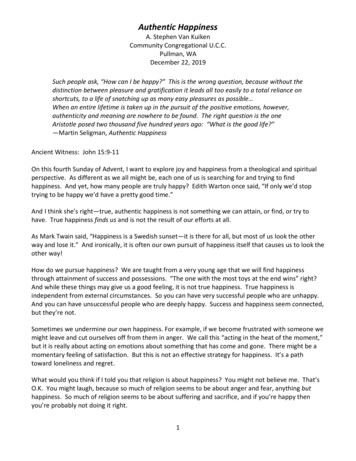
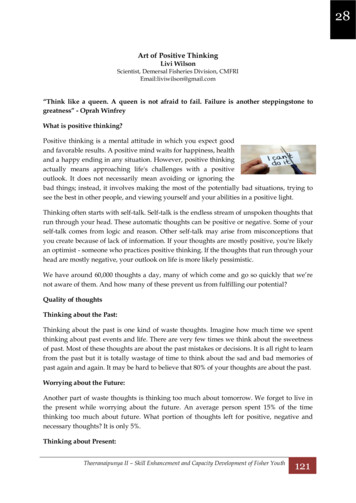
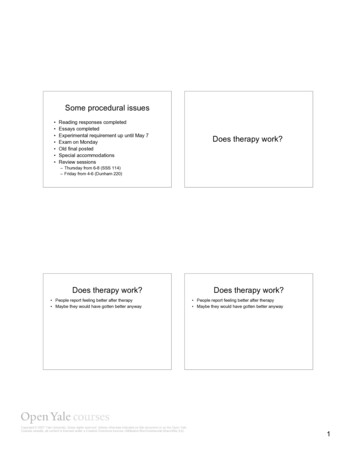
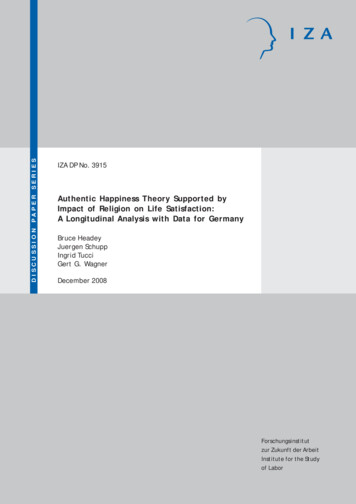
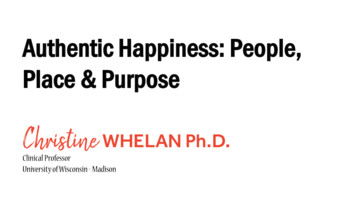

![INDEX [ actmindfully .au]](/img/14/2016-complete-worksheets-for-russ-harris-act-books.jpg)
![INDEX [thehappinesstrap ]](/img/14/complete-worksheets-2014.jpg)

![Does transition make you happy? [EBRD - Working papers]](/img/15/wp0091.jpg)